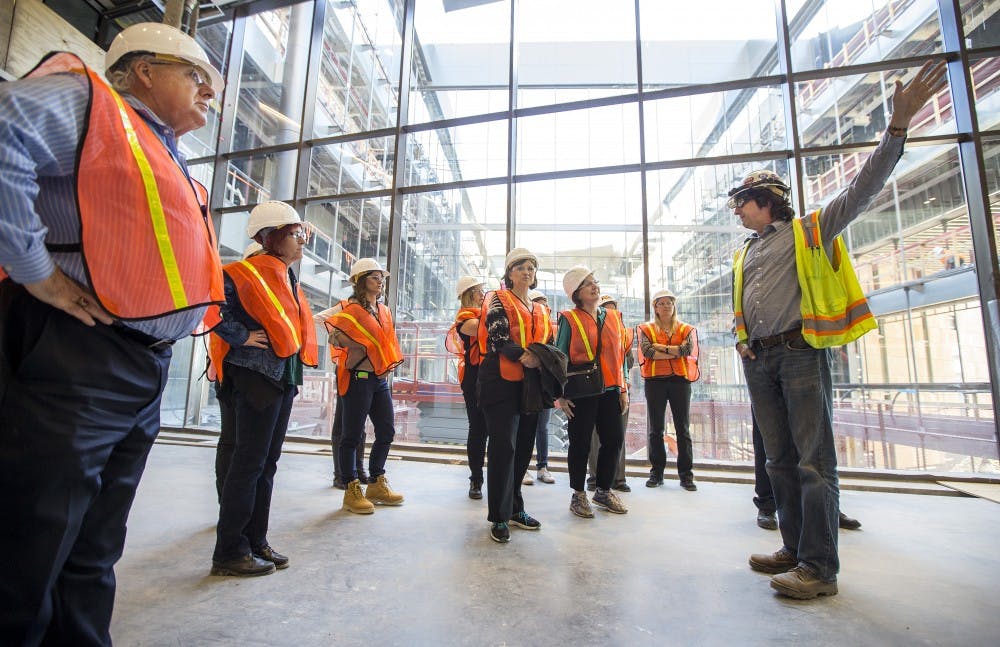With only three colleges and a fraction of the students it has now — it was ten years ago, in 2006, that the ASU Downtown Phoenix campus opened its doors.
Since August 21, 2006, the campus has grown in both size and reputation, and continues to develop with new additions like the Beus Center for Law and Society.
“When we first proposed an ASU Downtown Phoenix campus, a lot of people were not particularly enthused,” said Wellington Reiter, special adviser to the president of ASU and executive director of the University City Exchange, who worked directly on the conceptualization of the campus.
Still, Reiter said, the campus has exceeded his expectations in the past 10 years in terms of the University’s academic growth and the city of Phoenix’s economic growth.
Reiter said he began to discuss the possibility of creating a Downtown Phoenix campus with President Michael Crow in late 2004.
“If this is the sixth largest city in the United States, then its downtown area needed to demonstrate that,” he said. “It needed to be more vital.”
Not only did Reiter hope the urban setting would increase the number of professional experiences accessible to students, but he said he hoped it would create a unique campus that would benefit from studying in downtown Phoenix.
“What was going to be good for the city and the perception of downtown was going to be good for the region and thus, ultimately good for ASU,” Reiter said. “Imagine us trying to recruit students or faculty, and having them drive through a downtown that wasn’t active."
Both the city of Phoenix as well as the University shared mutual economic interests, such as increased pedestrian activity, new housing and retail developments, arts, culture, civic ambition and more, Reiter said.
“The University doesn’t exist without the place, and the city frankly, doesn’t thrive without the University,” he added.
In June 2005, Phoenix created the partnership with ASU, and former Phoenix mayor Phil Gordon championed the project, Reiter said.
In a groundbreaking two to one margin, Phoenix citizens approved the $223 million bond or funding, to create the campus. A collaboration between a city and a university of this scale was unprecedented until the vote, Reiter said.
The Downtown Phoenix campus’s newest addition, the Sandra Day O’Connor College of Law, is most likely the last full college to move to the campus, Reiter said. But the Herberger Institute for Design and Arts may increase its collaboration with Phoenix’s art and warehouse districts in the future.
Chris Callahan, dean of the Walter Cronkite School of Journalism and Mass Communication, CEO of Arizona PBS and university vice provost, has a mission to promote the growth and vibrancy of the Downtown Phoenix campus, he said.
Callahan said about 3,000 students attended the Downtown Phoenix campus when it first opened and today, about 13,000 students attend.
“It was a start-up,” Callahan said. “There were just a few buildings, and there wasn’t a density of student population, and quite frankly, the area around it had just started to grow.”
Callahan said the campus and the surrounding community have changed dramatically in the last ten years.
“If you look at the campus, the biggest change to me is the student body,” Callahan said. “There’s a real feel of a campus community where there’s a constant buzz of activity.”
The Downtown Phoenix campus alone is the same size as an entire mid-size university, he said.
“Not only has this created an incredibly vibrant college campus, but I think it's helped change in a very positive way the community around us,” Callahan said, explaining that most of the programs offered at the campus are extremely open to and involved with the surrounding community.
In addition to the increased number of art programs Reiter predicted, Callahan said he foresees the campus adding additional academic buildings to meet the needs of rising student enrollment.
"I like that it's small," said freshman nursing student Hannah Martinez, and said that she thinks the campus is big enough to be interesting, but small enough to avoid being confusing.
Senior criminology student Sydnee Schwartz said she believes ASU may add more programs to the Downtown Phoenix campus in the future if they require educational components in an urban setting. She said she sees a transformation coming within the campus.
By 2026, Schwartz said she thinks there will be "A lot more innovation incorporated into how this campus works and the functionality of the buildings."
Reach the reporter at ekamezak@asu.edu or follow her on Twitter @emikamezaki
Like The State Press on Facebook and follow @statepress on Twitter.




